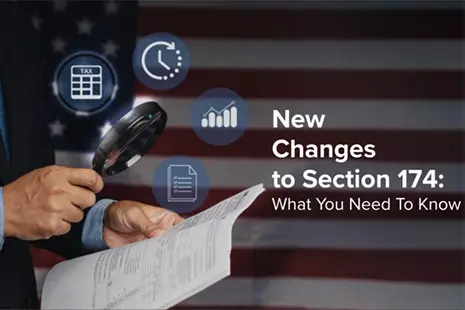The software and internet industry makes up almost 19% of all global research and development spending. To help companies further drive innovation, the US government allows them to claim tax credits on R&D expenses.
Software development companies and up-and-coming tech startups are both eligible for R&D tax credits. However, they’re not always crystal clear on what kind of work is eligible for a tax credit and how to properly file a claim.
To claim all the tax benefits your software company is entitled to, you need to be aware of the many IRS requirements that decide whether R&D activities are eligible for tax credits or not, including a four-part test.
The R&D Tax Credit in a Nutshell
The US federal government provides a tax incentive to all companies participating in research and development, which is known as the R&D tax credit. It’s available to established businesses as well as startups as long as they perform activities that qualify them for credits.
Use our free calculator to get an estimate of your R&D tax refund.
The R&D tax credit was established in 1981 and was made permanent in 2015 as part of the Protecting Americans From Tax Hikes (PATH) Act. The aim of the tax incentive is to reduce the financial burden on companies and enable them to reinvest in the business, spurring more innovation.
As part of the R&D tax credit, qualified small businesses and startups can claim funds to offset their payroll taxes. To do so, they must fulfill the following criteria:
- The business cannot be a tax-exempt organization as defined by section 501(c)(3) of the Internal Revenue Code.
- Gross receipts must not exceed $5 million for the tax year.
- The business doesn’t have any gross receipts prior to the 5-year period that ends with the tax year the business is applying.
Prior to the 2022 Inflation Reduction Act (IRA), the maximum amount startups could claim was $250K. The IRA has doubled this amount, allowing startups to claim up to $500K from January 1, 2023, onward.
Based in Canada? Look into the SR&ED tax incentive program.
R&D Tax Credits by State
The majority of US states have an R&D tax incentive that software development companies are also eligible for. The only states that do not are:
- Alabama
- Mississippi
- Montana
- Nevada
- North Carolina
- Oklahoma
- Oregon
- South Dakota
- Tennessee
- Washington
- West Virginia
- Wyoming
While most states with R&D tax credits follow the requirements set at the federal level, there are state-specific regulations to keep in mind.
- In Arizona, there are two categories of tax credits: non-refundable (24% credit for the first $2.5 million and 15% for all expenses exceeding that amount) and refundable (up to $100,000).
- In California, a company can get a maximum of $5 million in tax credits. Additionally, all qualifying activities must take place in California.
- In New York, a software development company must prove it has created at least five net new jobs to earn tax credits. In addition, businesses must complete a consolidated funding application and submit it to their Empire State Development (ESD) regional office.
In Texas, the guidelines that determine qualifying research and expenses follow the federal guidelines set by the IRS. Businesses can claim tax credits as sales tax exemptions and franchise tax credits.
The IRS Eligibility Test
For R&D activities to qualify for a tax credit, they must meet all the requirements of the IRS’ four-part test.
- The Section 174 Test
For an expense to pass the section 174 test, the company had to have incurred it as part of its business. Additionally, the expense must be an R&D cost “in the experimental or laboratory sense.” This means the activity was performed with the purpose of eliminating uncertainty during the process of product development or improvement.
The IRS considers “uncertainty” to exist if a company doesn’t have enough information to determine a method or capability to improve or develop a product.
- The Discovering Technological Information Test
Research activities are eligible if the company performs them to remove uncertainties regarding the improvement or development of a business component. For research to qualify as technological, it needs to be based on engineering or computer, physical, or biological sciences.
- The Business Component Test
A company must conduct research to improve existing or develop new business components. The IRS notes that many businesses fail to categorize research in relation to the business component they’re improving or developing, which must be done to claim credits.
The IRS defines business components as inventions, formulas, products, processes, software, or techniques that the company plans to sell, lease, use, or license as part of its business.
- The Process of Experimentation Test
As part of the process of experimentation test, the IRS requires that the business’ experimentation:
- Identifies the uncertainty related to improving or developing a business component.
- Identifies at least one or more alternatives that can eliminate the uncertainty.
- Identifies and carries out a process that evaluates the alternatives.
Expenses That Qualify for the R&D Tax Credit in Software Development
According to the IRS, the following expenses qualify for the R&D tax credit:
- Employee wages, excluding non-taxed income. The wages must be paid for “qualified services,” which includes performing qualified research, directly supervising qualified research, or providing direct support to qualified research.
- Research supplies, which must have a direct relation to performing qualified services. The IRS excludes property and administrative work from research supplies.
- Contract research expenses, which refers to 65% of the expenses related to research performed by a third party on behalf of the business.
Activities That do not Qualify for the R&D Tax Credit in Software Development
The IRS excludes the following activities from qualifying for the R&D tax credit:
- Research after commercial production. The IRS considers a business component ready for commercial production when it’s ready to use or fulfills the basic requirements of the company.
- Adaptation of business components. If a company adapts a business component to fit a specific customer’s needs, the IRS will not consider it qualified research eligible for the tax credit.
- Duplication. If a company reproduces a part or the entirety of an existing business component, this activity will be excluded from qualified research.
- Surveys, studies, or research relating to management functions. Under this exclusion, activities such as conducting efficiency surveys or developing employee training are not qualified research activities.
- Internal-use software. Only internal-use software used in financial management, HR management, and support services is eligible for the tax credit.
- Foreign research. The IRS excludes research conducted outside the US, any possession of the US, or Puerto Rico.
- Research in the social sciences. Any research in the field of economics, arts, humanities, business management, and behavioral sciences isn’t eligible for the tax credit.
- Funded research. Research isn’t eligible for the tax credit if it was funded by another person or government entity.
Simplify Tax Credit Claims With Boast AI
Claiming R&D tax credits for software development companies can be a challenging and time-consuming process. Companies are often unaware that they’re not maximizing their tax credits and lose out on money they can reinvest in their business.
BoastClaim R&D is an AI-powered solution that uses company data from payroll, accounting, and project-tracking systems to identify eligible expenses and projects. The results are 15% larger claims and 60 hours saved on a yearly basis.
Download our ultimate guide to R&D tax credits to learn more about calculating your R&D return, get documentation tips, and access two industry case studies.


